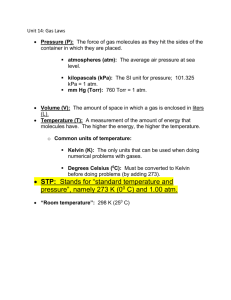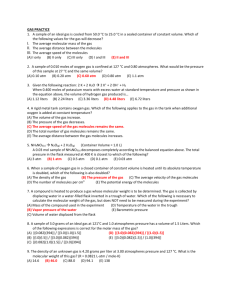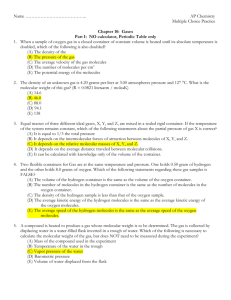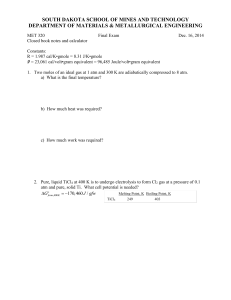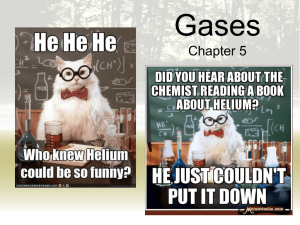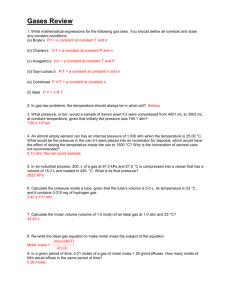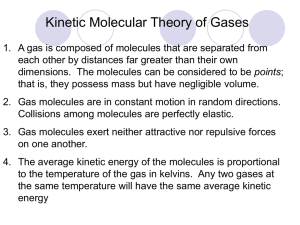AP Practice Questions 1984 1. When a sample of oxygen gas in a
advertisement
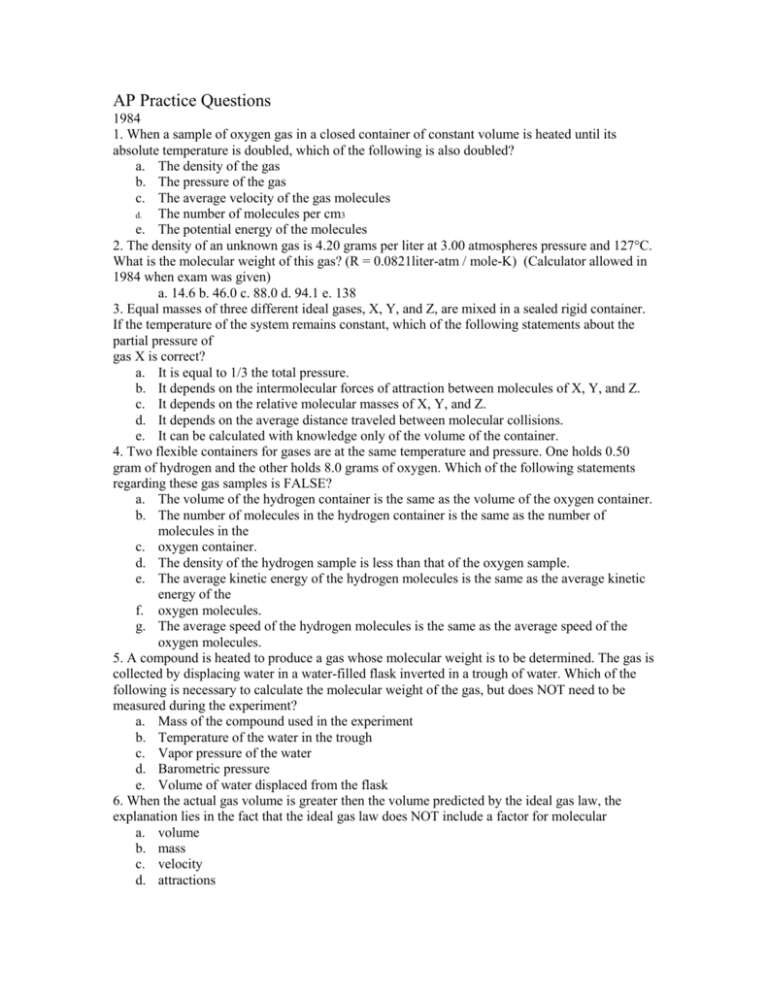
AP Practice Questions 1984 1. When a sample of oxygen gas in a closed container of constant volume is heated until its absolute temperature is doubled, which of the following is also doubled? a. The density of the gas b. The pressure of the gas c. The average velocity of the gas molecules d. The number of molecules per cm3 e. The potential energy of the molecules 2. The density of an unknown gas is 4.20 grams per liter at 3.00 atmospheres pressure and 127°C. What is the molecular weight of this gas? (R = 0.0821liter-atm / mole-K) (Calculator allowed in 1984 when exam was given) a. 14.6 b. 46.0 c. 88.0 d. 94.1 e. 138 3. Equal masses of three different ideal gases, X, Y, and Z, are mixed in a sealed rigid container. If the temperature of the system remains constant, which of the following statements about the partial pressure of gas X is correct? a. It is equal to 1/3 the total pressure. b. It depends on the intermolecular forces of attraction between molecules of X, Y, and Z. c. It depends on the relative molecular masses of X, Y, and Z. d. It depends on the average distance traveled between molecular collisions. e. It can be calculated with knowledge only of the volume of the container. 4. Two flexible containers for gases are at the same temperature and pressure. One holds 0.50 gram of hydrogen and the other holds 8.0 grams of oxygen. Which of the following statements regarding these gas samples is FALSE? a. The volume of the hydrogen container is the same as the volume of the oxygen container. b. The number of molecules in the hydrogen container is the same as the number of molecules in the c. oxygen container. d. The density of the hydrogen sample is less than that of the oxygen sample. e. The average kinetic energy of the hydrogen molecules is the same as the average kinetic energy of the f. oxygen molecules. g. The average speed of the hydrogen molecules is the same as the average speed of the oxygen molecules. 5. A compound is heated to produce a gas whose molecular weight is to be determined. The gas is collected by displacing water in a water-filled flask inverted in a trough of water. Which of the following is necessary to calculate the molecular weight of the gas, but does NOT need to be measured during the experiment? a. Mass of the compound used in the experiment b. Temperature of the water in the trough c. Vapor pressure of the water d. Barometric pressure e. Volume of water displaced from the flask 6. When the actual gas volume is greater then the volume predicted by the ideal gas law, the explanation lies in the fact that the ideal gas law does NOT include a factor for molecular a. volume b. mass c. velocity d. attractions e. shape 7. A sample of 9.00 grams of aluminum metal is added to an excess of hydrochloric acid. The volume of hydrogen gas produced at standard temperature and pressure is a. 22.4 L b. 11.2 L c. 7.46 L d. 5.60 L e. 3.74 L 1989 8. A gaseous mixture containing 7.0 moles of nitrogen, 2.5 moles of oxygen, and 0.50 mole of helium exerts a total pressure of 0.90 atmosphere. What is the partial pressure of the nitrogen? a. 0.13 atm b. 0.27 atm c. 0.63 atm d. 0.90 atm e. 6.3 atm 9. Hydrogen gas is collected over water at 24°C. The total pressure of the sample is 755 millimeters of mercury. At 24°C, the vapor pressure of water is 22 millimeters of mercury. What is the partial pressure of the hydrogen gas? a. 22 mm Hg b. 733 mm Hg c. 755 mm Hg d. 760 mm Hg e. 777 mm Hg 10. A 2.00-liter sample of nitrogen gas at 27°C and 600. millimeters of mercury is heated until it occupies a volume of 5.00 liters. If the pressure remains unchanged, the final temperature of the gas is a. 68°C b. 120°C c. 477°C d. 677°C e. 950.°C 11. 2 K + 2 H2O → 2 K+ + 2 OH- + H2 When 0.400 mole of potassium reacts with excess water at standard temperature and pressure as shown in the equation above, the volume of hydrogen gas produced is a. 1.12 liters b. 2.24 liters c. 3.36 liters d. 4.48 liters e. 6.72 liters 12. As the temperature is raised from 20°C to 40°C, the average kinetic energy of neon atoms changes by a factor of a. 1/2 b. (313/293) 1/2 c. 313/293 d. 2 e. 4 1994 Multiple Choice 24. A sample of 0.010 mole of oxygen gas is confined at 127 °C and 0.80 atmosphere. What would be the pressure of this sample at 27 °C and the same volume? a. 0.10 atm b. 0.20 atm c. 0.60 atm d. 0.80 atm e. 1.1 atm 37. A sample of 3.0 grams of an ideal gas at 127°C and 1.0 atmosphere pressure has a volume of 1.5 liters. Which of the following expressions is correct for the molar mass of the gas? The ideal gas constant, R, is 0.08 (L-atm) / (mole K). a. [(0.08)(400)] / [(3.0)(1.0)(1.5)] b. [(1.0)(1.5)] / [(3.0)(0.08)(400)] c. [(0.08)(1.0)(1.5)] / [(3.0)(400)] d. [(3.0)(0.08)(400)] / [(1.0)(1.5)] e. [(3.0)(0.08)(1.5)] / (1.0)(400)] 39. Samples of F2 gas and Xe gas are mixed in a container of fixed volume. The initial partial pressure of the F2 gas is 8.0 atmospheres and that of the Xe gas is 1.7 atmospheres. When all of the Xe gas reacted, forming a solid compound, the pressure of the unreacted F2 gas was 4.6 atmospheres. The temperature remained constant. What is the formula of the compound? a. XeF b. XeF3 c. XeF4 d. XeF6 e. XeF8 40. The system shown is at equilibrium at 28°C. At this temperature, the vapor pressure of water is 28 millimeters of mercury. The partial pressure of O2(g) in the system is a. 28 mm Hg b. 56 mm Hg c. 133 mm Hg d. 161 mm Hg e. 189 mm Hg 45. A sample of an ideal gas is cooled from 50.0 °C to 25.0 °C in a sealed container of constant volume. Which of the following values for the gas will decrease? I. The average molecular mass of the gas II. The average distance between the molecules III. The average speed of the molecules a. I only b. II only c. III only d. I and III e. II and III 64. At 25 °C, a sample of NH3 (molar mass 17 grams) effuses at the rate of 0.050 mole per minute. Under the same conditions, which of the following gases effuses at approximately onehalf that rate? a. O2 (molar mass 32 grams) b. He2 (molar mass 4.0 grams) c. CO2 (molar mass 44 grams) d. Cl2 (molar mass 71 grams) e. CH4 (molar mass 16 grams) 1999 Multiple Choice 44. A rigid metal tank contains oxygen gas. Which of the following applies to the gas in the tank when additional oxygen is added at constant temperature? a. The volume of the gas increases. b. The pressure of the gas decreases. c. The average speed of the gas molecules remains the same. d. The total number of gas molecules remains the same. e. The average distance between the gas molecules increases. W(g) + X(g) → Y(g) + Z(g) 53. Gases W and X react in a closed, rigid vessel to form gases Y and Z according to the equation above. The initial pressure of W(g) is 1.20 atm and that of X(g) is 1.60 atm. No Y(g) or Z(g) is initially present. The experiment is carried out at constant temperature. What is the partial pressure of Z(g) when the partial pressure of W(g) has decreased to 1.0 atm? a. 0.20 atm b. 0.40 atm c. 1.0 atm d. 1.2 atm e. 1.4 atm 64. Equal numbers of moles of He(g), Ar(g), and Ne(g) are placed in a glass vessel at room temperature. If the vessel has a pinhole-sized leak, which of the following will be true regarding the relative values of the partial pressures of the gases remaining in the vessel after some of the gas mixture has effused? a. PHe < PNe < PAr b. PHe < PAr < PNe c. PNe < PAr < PHe d. PAr < PHe < PNe e. PHe = PAr = PNe 74. Which of the following gases deviates most from ideal behavior? a. SO2 b. Ne c. CH4 d. N2 e. H2 2002 Questions 8-10 refer to the following gases at 0°C and 1 atm. (A) Ne (B) Xe (C) O2 (D) CO (E) NO 8. Has an average atomic or molecular speed closest to that of N2 molecules at 0°C and 1 atm 9. Has the greatest density 10. Has the greatest rate of effusion through a pinhole 20. A flask contains 0.25 mole of SO2(g), 0.50 mole of CH4(g), and 0.50 mole of O2(g). The total pressure of the gases in the flask is 800 mm Hg. What is the partial pressure of the SO2(g) in the flask? a. 800 mm Hg b. 600 mm Hg c. 250 mm Hg d. 200 mm Hg e. 160 mm Hg CS2(l) + 3 O2(g) → CO2 (g) + 2 SO2(g) 40. An excess of Mg(s) is added to 100. mL of 0.400 M HCl. At 0°C and 1 atm pressure, what volume of H2 gas can be obtained? a. 22.4 mL b. 44.8 mL c. 224 mL d. 448 mL e. 896 mL 66. A 2 L container will hold about 4 g of which of the following gases at 0°C and 1 atm? a. SO2 b. N2 c. CO2 d. C4H8 e. NH3


